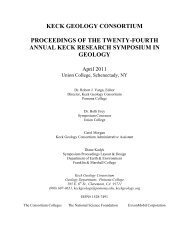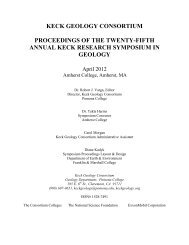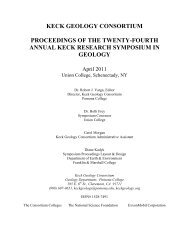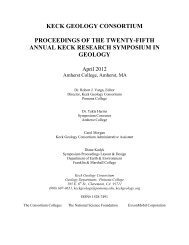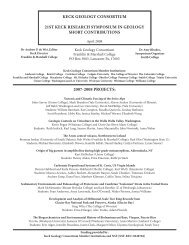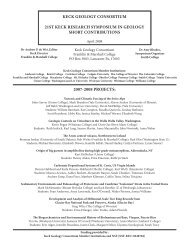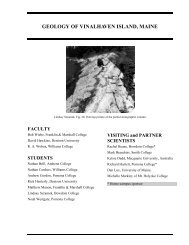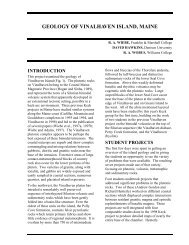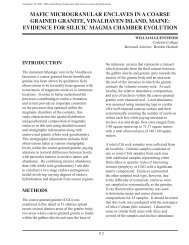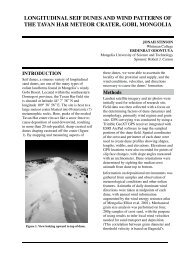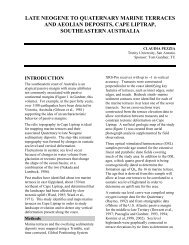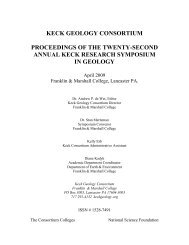determining the thickness of sediments using seismic refraction ...
determining the thickness of sediments using seismic refraction ...
determining the thickness of sediments using seismic refraction ...
Create successful ePaper yourself
Turn your PDF publications into a flip-book with our unique Google optimized e-Paper software.
http://keck.wooster.edu/publications/eighteenthannual…<br />
DETERMINING THE THICKNESS OF SEDIMENTS USING<br />
SEISMIC REFRACTION, CYCLONE GRABEN,<br />
CANYONLANDS NATIONAL PARK, UTAH<br />
JENNIFER ABRAHAMSON<br />
Beloit College<br />
Sponsor: Susan Swanson<br />
INTRODUCTION<br />
The Needles District within Canyonlands<br />
National Park, Utah (Fig. 1) is an excellent<br />
area to study fault geometry because <strong>the</strong><br />
grabens are small and relatively straight.<br />
Cleanly exposed faults can provide important<br />
insight into graben geometry and mechanics <strong>of</strong><br />
<strong>the</strong>ir formation on a kilometer scale; however,<br />
<strong>the</strong> normal faults bounding <strong>the</strong> grabens in<br />
Canyonlands are not completely exposed due<br />
to a layer <strong>of</strong> sediment. McGill and Stromquist<br />
(1979) found that a sequence <strong>of</strong> alluvial,<br />
colluvial, and eolian sediment obscures <strong>the</strong><br />
bedrock floor <strong>of</strong> <strong>the</strong> hanging-wall block in<br />
most graben locations, complicating <strong>the</strong> direct<br />
measurement <strong>of</strong> <strong>the</strong> fault displacement.<br />
Geophysical methods can provide insight into<br />
<strong>the</strong> <strong>thickness</strong> <strong>of</strong> <strong>the</strong>se <strong>sediments</strong> and thus<br />
allow for an estimate <strong>of</strong> fault displacement and<br />
fault geometry.<br />
In July and August <strong>of</strong> 2004, <strong>the</strong> Keck Geology<br />
Consortium sponsored geophysical research to<br />
determine <strong>the</strong> <strong>thickness</strong> <strong>of</strong> <strong>sediments</strong> that<br />
obscure <strong>the</strong> bedrock in <strong>the</strong> bottom <strong>of</strong> Cyclone<br />
Graben in <strong>the</strong> Needles District <strong>of</strong> Canyonlands<br />
National Park (Fig. 1). Cyclone Graben is 5<br />
km long and approximately 230 m wide,<br />
making it an ideal location to conduct a<br />
geophysical survey. The graben deforms a<br />
sequence <strong>of</strong> Pennsylvanian to Early Permian<br />
clastic sedimentary rocks that overlie <strong>the</strong><br />
Pennsylvanian Paradox evaporite sequence.<br />
There are thought to be at least two<br />
paleochannels transecting Cyclone Graben,<br />
but <strong>the</strong> <strong>thickness</strong> <strong>of</strong> sediment in <strong>the</strong> channels<br />
is uncertain. The purpose <strong>of</strong> this study is to<br />
determine whe<strong>the</strong>r <strong>the</strong> nor<strong>the</strong>rnmost<br />
paleochannel exists and, if it does, to<br />
determine <strong>the</strong> <strong>thickness</strong> <strong>of</strong> sediment within<br />
this channel.<br />
Figure 1. Index map <strong>of</strong> <strong>the</strong> Canyonlands area<br />
showing <strong>the</strong> location <strong>of</strong> grabens. Cyclone Graben<br />
is in <strong>the</strong> nor<strong>the</strong>ast section <strong>of</strong> <strong>the</strong> grabens<br />
(modified from McGill and Stromquist, 1979).<br />
METHODS<br />
Data Acquisition<br />
Seismic <strong>refraction</strong> data were collected during<br />
<strong>the</strong> summer <strong>of</strong> 2004 in order to gain a better<br />
7
http://keck.wooster.edu/publications/eighteenthannual…<br />
understanding <strong>of</strong> sediment <strong>thickness</strong> as a<br />
function <strong>of</strong> position along <strong>the</strong> length <strong>of</strong><br />
Cyclone Graben. This study considers two<br />
<strong>refraction</strong> lines, one transecting <strong>the</strong> possible<br />
paleochannel (Array 1), and ano<strong>the</strong>r nearby,<br />
but not transecting it (Array 2) (Fig. 2).<br />
Figure 3. The PEG40 is an advanced<br />
accelerated weight drop that weighs 38 kg.<br />
It is attached to <strong>the</strong> back <strong>of</strong> a truck and<br />
powered by a 12-volt battery.<br />
Figure 2. A digital elevation model <strong>of</strong> <strong>the</strong><br />
locations <strong>of</strong> Array 1 (a possible paleochannel)<br />
and Array 2 (near <strong>the</strong> paleochannel). Array 1 is<br />
north <strong>of</strong> Array 2. Each array is approximately<br />
470 m long.<br />
Two spreads <strong>of</strong> P-wave <strong>refraction</strong> data were<br />
obtained <strong>using</strong> two 24-channel Geometrics<br />
Geodes and 10-Hz geophones, creating a 48-<br />
channel spread. A 38 kg accelerated weightdrop<br />
system (PEG40) was used as an energy<br />
source (Fig. 3). This source was <strong>the</strong> most<br />
environmentally friendly source that could be<br />
obtained and used in <strong>the</strong> National Park. Both<br />
spreads, or arrays, <strong>of</strong> 17 shot points were<br />
oriented in a north-south direction and<br />
centered in <strong>the</strong> graben in order to reduce<br />
interference from talus blocks and <strong>the</strong> graben<br />
walls. Geophone spacing for <strong>the</strong> spreads was<br />
10 m. Shots were set <strong>of</strong>f every 30 m. Four to<br />
16 shots were stacked at each shot point to<br />
enhance <strong>the</strong> arrivals at distant geophones and<br />
to increase <strong>the</strong> signal to noise ratio at all <strong>of</strong> <strong>the</strong><br />
geophones.<br />
Data Analysis<br />
The two arrays were used to determine <strong>the</strong><br />
sediment <strong>thickness</strong> within (Array 1) and in <strong>the</strong><br />
vicinity <strong>of</strong> <strong>the</strong> paleochannel (Array 2). Data<br />
were analyzed <strong>using</strong> <strong>the</strong> s<strong>of</strong>tware programs<br />
PickWin95 and Plotrefa from <strong>the</strong> SeisImager<br />
s<strong>of</strong>tware package (OYO Corporation, 2004).<br />
These programs allow cross-sectional areas <strong>of</strong><br />
<strong>the</strong> subsurface beneath each array to be<br />
plotted, thus modeling <strong>the</strong> sediment-bedrock<br />
interface <strong>using</strong> a time-term inversion method<br />
(OYO Corporation, 2004). A three-layer<br />
model was employed to represent <strong>the</strong><br />
sandstone bedrock, basin fill material, and a<br />
thin layer <strong>of</strong> wind-blown sediment.<br />
Raw field data were imported into PickWin95<br />
and <strong>the</strong> first arrivals <strong>of</strong> <strong>the</strong> P-waves were<br />
chosen. This was performed for each <strong>of</strong> <strong>the</strong><br />
17 shot points along <strong>the</strong> arrays. The first<br />
arrival data were imported into Plotrefa, and a<br />
plot <strong>of</strong> time versus distance (1/v) was<br />
generated (Fig. 4). Plotrefa automatically<br />
checks reciprocal times for multiple shot<br />
locations. It is best if <strong>the</strong> root mean square<br />
8
http://keck.wooster.edu/publications/eighteenthannual…<br />
(RMS) error is less than 5%. Most <strong>of</strong> <strong>the</strong> data<br />
points in both Array 1 and Array 2 have RMS<br />
Figure 4. First arrival data for paleochannel imported into<br />
Plotrefa. This shows a three-layer model and <strong>the</strong> crossover points<br />
for each layer.<br />
values below 0.05; however, <strong>the</strong>re are some<br />
data points with higher RMS errors.<br />
Layers are assigned by identifying crossover<br />
points, which occur where <strong>the</strong> slope <strong>of</strong> 1/v<br />
changes. The crossover point separating<br />
wind-blown sediment from basin fill material<br />
is minor, but <strong>the</strong> change in slope between<br />
basin fill material and sandstone bedrock is<br />
distinct.<br />
Figure 5. The apparent velocities for end shots <strong>of</strong><br />
<strong>the</strong> paleochannel array are asymmetric, indicating<br />
minor topography in <strong>the</strong> bedrock surface.<br />
After <strong>the</strong> layer assignment, a time-term<br />
inversion model can be run. Velocity is<br />
calculated, and from <strong>the</strong> model depth<br />
is inferred. Models were created for<br />
both arrays. Three models for Array<br />
1 and two models for Array 2 were<br />
generated <strong>using</strong> different first arrival<br />
picks in order to gain an<br />
understanding <strong>of</strong> model sensitivity.<br />
RESULTS<br />
Irregularities in apparent velocity<br />
between <strong>the</strong> forward shot and <strong>the</strong><br />
reverse shot may indicate topography<br />
along <strong>the</strong> bedrock-sediment<br />
interface. A sharp break in apparent<br />
velocity occurs on both arrays at<br />
longer <strong>of</strong>fsets. These apparent<br />
velocities are slightly asymmetric<br />
between forward and reverse shots,<br />
indicating a dipping surface (Fig. 5).<br />
The irregularities are minor;<br />
<strong>the</strong>refore <strong>the</strong> topography along <strong>the</strong><br />
interface is probably not dramatic.<br />
Models created in Plotrefa generate depths <strong>of</strong><br />
<strong>the</strong> sediment based upon <strong>the</strong> calculated<br />
velocities (Fig. 5). The depth <strong>of</strong> sediment is<br />
approximately 75 m for Array 1, and<br />
approximately 60 m for Array 2. Within<br />
Array 1, velocities <strong>of</strong> <strong>the</strong> wind-blown<br />
sediment, <strong>the</strong> basin fill material, and bedrock<br />
are 382 m/s, 706 m/s, and 1908 m/s,<br />
respectively. In Array 2, <strong>the</strong> velocities <strong>of</strong> <strong>the</strong><br />
wind-blown <strong>sediments</strong>, <strong>the</strong> basin fill material,<br />
and bedrock are 428 m/s, 1051 m/s, and 2885<br />
m/s, respectively (Fig. 6).<br />
INTERPRETATION<br />
Modeling results for both arrays generally<br />
agree with existing information from Devils<br />
Lane, a nearby graben (Grosfils et al., 2003).<br />
The bedrock velocities for Array 1 are slightly<br />
slower than those found by Grosfils et al.<br />
(2003), but are indicative <strong>of</strong> sandstone<br />
bedrock in <strong>the</strong> region. The variability may be<br />
due to a siltier bedrock lithology in this graben<br />
or more extensive fracturing in <strong>the</strong> bedrock<br />
floor <strong>of</strong> this graben.<br />
The velocities found by Grosfils et al. (2003)<br />
ranged from 2000 m/s to approximately 3000<br />
9
http://keck.wooster.edu/publications/eighteenthannual…<br />
m/s, with a calculated sediment depth <strong>of</strong> 70-90<br />
m. Bedrock velocities calculated in Cyclone<br />
Graben range from 1908 m/s for Array 1 to<br />
2885 m/s for Array 2. The velocities for <strong>the</strong><br />
<strong>sediments</strong> in Devils Lane range from 700 m/s<br />
to 1000 m/s, which are similar to those found<br />
in Cyclone Graben.<br />
a)<br />
b)<br />
Figure 6. a) The depth and velocities for Array 1.<br />
b) The depth and velocities for Array 2. Depths<br />
implied from <strong>the</strong> model are approximately 75 m<br />
for Array 1 and approximately 60 m for Array 2.<br />
Velocities in <strong>the</strong> model are given in m/s.<br />
Graben. Both models suggest a maximum<br />
unconsolidated sediment <strong>thickness</strong> <strong>of</strong> 60 m to<br />
75 m. Because <strong>the</strong> graben walls are<br />
approximately 80 m high, modeling results for<br />
<strong>the</strong>se two arrays indicate <strong>the</strong> fault<br />
displacement in Cyclone Graben is at least<br />
140 m to 155 m.<br />
Fur<strong>the</strong>r comparison <strong>of</strong> different geophysical<br />
methods within both grabens will remove nonuniqueness<br />
from <strong>the</strong> data. Collaboration<br />
among members <strong>of</strong> <strong>the</strong> Keck project will<br />
allow fur<strong>the</strong>r examination <strong>of</strong> <strong>the</strong> geologic<br />
properties <strong>of</strong> Cyclone Graben, and will<br />
provide additional insight into <strong>the</strong> graben<br />
geometry and mechanics in Canyonlands<br />
National Park.<br />
REFERENCES CITED<br />
Grosfils, E.B., Schultz, R.A., and Kroeger, G., 2003,<br />
Geophysical exploration within nor<strong>the</strong>rn Devils<br />
Lane graben, Canyonlands National Park, Utah:<br />
implications for sediment <strong>thickness</strong> and tectonic<br />
evolution: Journal <strong>of</strong> Structural Geology, vol. 25,<br />
p. 455-467.<br />
McGill, G.E., Stromquist, A.W., 1979, The grabens <strong>of</strong><br />
Canyonlands National Park, Utah—geometry,<br />
mechanics and kinematics: Journal <strong>of</strong> Geophysical<br />
Research, vol. 84, p. 4547-4563.<br />
OYO Corporation, 2004, SeisImager Manual Version<br />
3.0 [Computer program manual]: Japan: OYO<br />
Corporation.<br />
Array 1 does not show obvious preservation <strong>of</strong><br />
a paleochannel in <strong>the</strong> bedrock floor <strong>of</strong> <strong>the</strong><br />
graben where <strong>the</strong>re was thought to be one<br />
(Fig. 6a). However, <strong>the</strong> velocity calculated by<br />
<strong>the</strong> s<strong>of</strong>tware in this area is lower than o<strong>the</strong>r<br />
areas <strong>of</strong> basin fill (Fig. 6b). This may be<br />
evidence for <strong>the</strong> existence <strong>of</strong> an ancient fluvial<br />
system in this part <strong>of</strong> <strong>the</strong> graben.<br />
Both models show irregularities in <strong>the</strong> bedrock<br />
surface, but nei<strong>the</strong>r shows a distinct channel.<br />
Array 2 shows increasing sediment <strong>thickness</strong><br />
to <strong>the</strong> north (Fig. 6b), indicating gradual<br />
deepening <strong>of</strong> <strong>the</strong> graben.<br />
The ultimate purpose <strong>of</strong> this project is to<br />
determine fault displacement in Cyclone<br />
10



